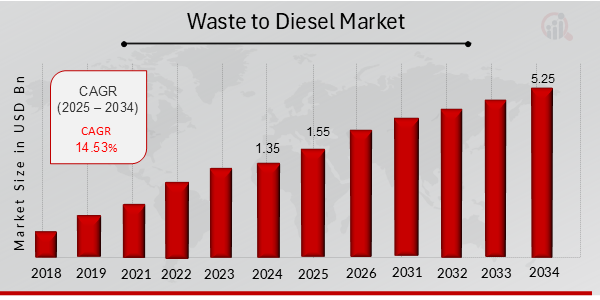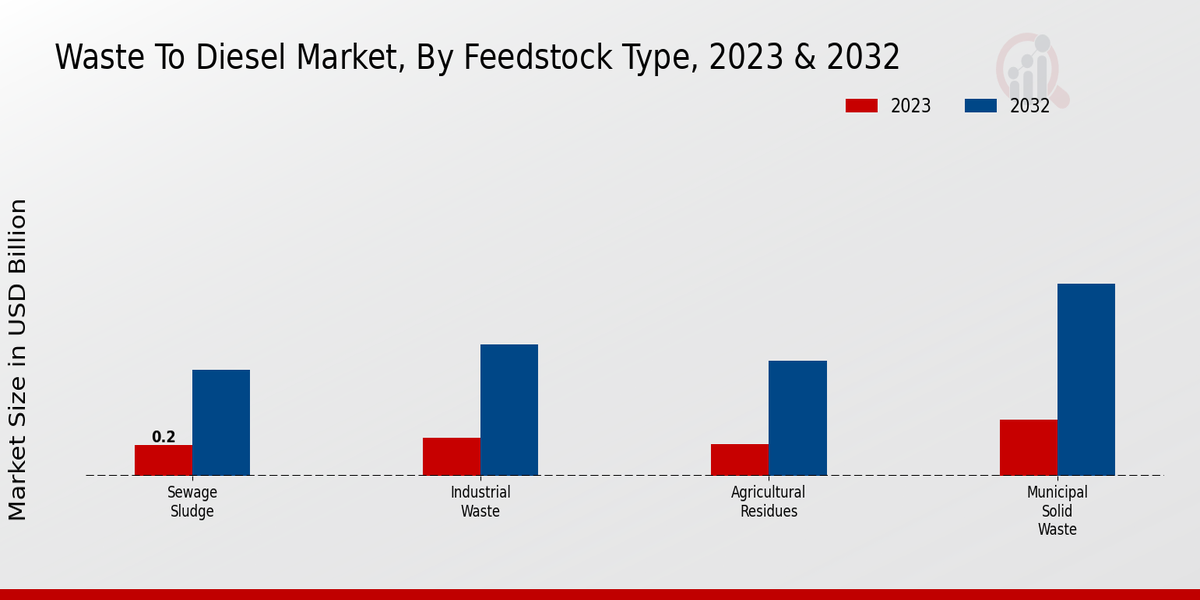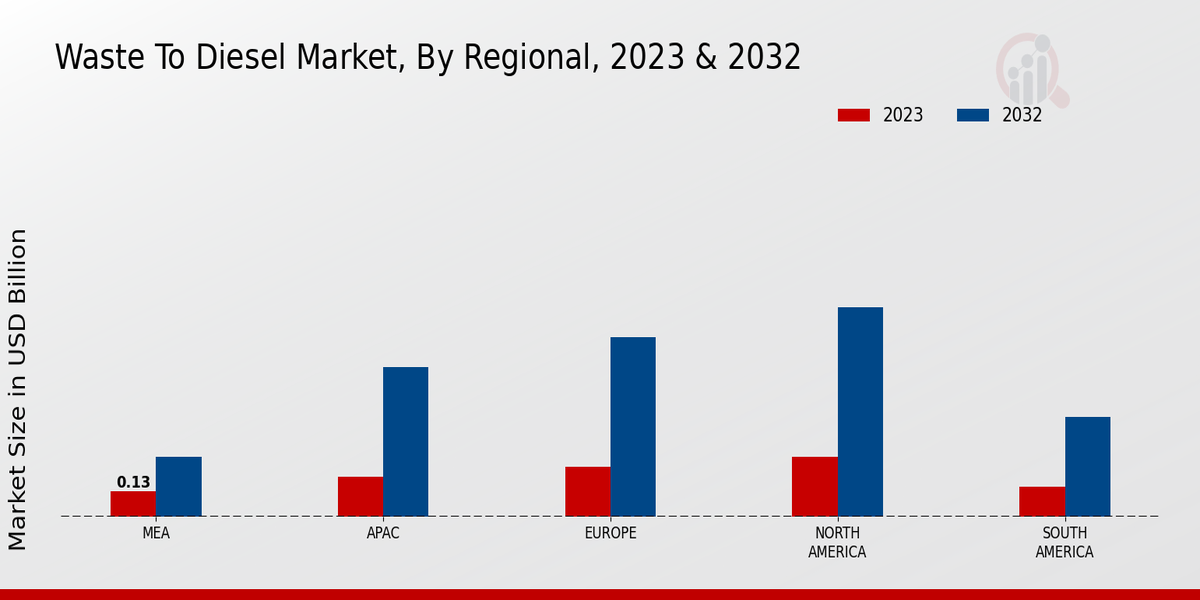Global Waste To Diesel Market Overview
As per MRFR analysis, the Waste to Diesel Market Size was estimated at 1.35 (USD Billion) in 2024. The Waste to Diesel Market Industry is expected to grow from 1.55 (USD Billion) in 2025 to 5.25 (USD Billion) till 2034, at a CAGR (growth rate) is expected to be around 14.53% during the forecast period (2025 - 2034).
Key Waste to Diesel Market Trends Highlighted
The Waste to Diesel Market is experiencing significant growth driven by various factors, including the increasing global emphasis on sustainable waste management practices and the urgent need to reduce environmental pollution. The demand for alternative energy sources has intensified as governments and industries seek to meet stringent regulations regarding waste disposal and carbon emission reductions. Rising awareness among consumers about the benefits of recycling and converting waste into valuable resources is also propelling market expansion. This momentum is supported by advancements in technology, enabling more efficient conversion processes that enhance the viability of waste-to-diesel initiatives.
Several opportunities can be explored in this evolving market. Innovations in conversion technologies, such as pyrolysis and gasification, present significant potential for enhancing efficiency and reducing costs associated with waste-to-diesel production. Additionally, the emergence of strategic partnerships and collaborations among technology providers and waste management companies can lead to enhanced operational capabilities. Expanding into emerging markets with growing waste management challenges represents another area where businesses can establish a foothold and drive revenue growth.
Recent trends indicate a growing interest in integrating circular economy principles within the waste-to-diesel sector. Companies are increasingly focusing on the lifecycle of products, promoting waste-as-resource strategies that align with sustainable development goals. In addition, consumers are showing a heightened preference for eco-friendly products, which compels manufacturers to adopt greener technologies. Such shifts are shaping the landscape of the waste-to-diesel market, encouraging efforts towards not just waste reduction but also a cleaner energy future. Overall, the interplay of these dynamics continues to create a favorable environment for innovation and investment in the waste-to-diesel space.

Source: Primary Research, Secondary Research, MRFR Database and Analyst Review
Waste To Diesel Market Drivers
Increased Environmental Awareness and Sustainable Practices
The rising concern regarding environmental issues has become a crucial driver for the Waste to Diesel Market industry. As the world faces challenges such as climate change, pollution, and the depletion of fossil fuels, there is an increasing push towards sustainable practices and green technologies across various sectors. Waste-to-diesel technology emerges as a viable solution to address these environmental challenges by converting waste materials, including plastics and organic waste, into diesel fuel, thereby reducing landfill waste and greenhouse gas emissions.
This conversion process not only contributes to a cleaner environment but also aligns with global sustainability goals, including the reduction of dependency on non-renewable energy sources. Governments and regulatory bodies are actively promoting policies and incentives to encourage industries to adopt waste-to-energy technologies, ultimately contributing to the growth of the Waste to Diesel Market industry. Additionally, public awareness campaigns and advocacy for renewable energy sources are fostering a culture that supports the transition towards eco-friendly alternatives.
Government Initiatives and Support
Many governments across the globe are implementing favorable policies and frameworks to promote the utilization of alternative fuels and renewable energy sources, including the waste-to-diesel sector. Regulatory incentives such as tax breaks, grants, and subsidies encourage investments in waste-to-diesel technologies, thereby facilitating market growth. Such initiatives reflect a broader commitment to reducing greenhouse gas emissions and enhancing energy security, further driving the Waste to Diesel Market industry.
Technological Advancements in Waste Processing
The continuous evolution of technologies related to waste processing and fuel production plays a significant role in the expansion of the Waste to Diesel Market industry. Innovations in catalytic processes, feedstock conversion, and refining methods have improved the efficiency, cost-effectiveness, and yield of diesel produced from waste. These advancements also help reduce operational costs and enhance product quality, making waste-to-diesel solutions more attractive to stakeholders.
Waste to Diesel Market Segment Insights:
Waste to Diesel Market Feedstock Type Insights
The Waste to Diesel Market, focused on the Feedstock Type segment, showcases a diverse array of sources contributing to the overall market value. In 2023, the market was valued at 1.03 USD Billion, with expectations of considerable growth over the coming years. Notably, Municipal Solid Waste dominates this segment with a valuation of 0.37 USD Billion in 2023, projected to increase to 1.27 USD Billion by 2032, indicating its significant role in the energy transition and waste management strategies. The significance of Municipal Solid Waste lies in its abundance and potential for conversion into sustainable fuel, addressing both waste disposal issues and energy demands simultaneously.
Meanwhile, Industrial Waste is valued at 0.25 USD Billion in 2023, with expectations to rise to 0.87 USD Billion by 2032. This segment is crucial as it represents a valuable feedstock from various manufacturing processes, showcasing a sustainable solution to reducing landfill waste while providing a renewable energy source. Agricultural Residues, valued at 0.21 USD Billion currently and forecasted to reach 0.76 USD Billion by 2032, play a critical role as they utilize by-products from farming practices, contributing to the circular economy and promoting sustainability in agriculture.
Lastly, Sewage Sludge, with a valuation of 0.2 USD Billion in 2023, representing a growing area of interest, is expected to expand to 0.7 USD Billion by 2032, highlighting the efficient transformation of an underutilized resource into clean energy. Each feedstock type contributes uniquely to the Waste to Diesel Market, with distinct advantages and challenges, reflecting the broader trends of renewable energy adoption and waste reduction initiatives. Moreover, the anticipated growth in these segments aligns with increasing regulatory support and technological advancements driving market growth, presenting opportunities for innovation and investment in sustainable practices within the waste management and energy sectors.

Source: Primary Research, Secondary Research, MRFR Database and Analyst Review
Waste to Diesel Market Technology Insights
The Waste to Diesel Market, valued at 1.03 USD Billion in 2023, is experiencing notable growth, driven by advancements in Technology. Within this landscape, technologies such as Thermal Conversion, Biochemical Conversion, and Gasification play critical roles in converting waste into diesel fuel. Thermal Conversion is significant due to its ability to handle a variety of feedstocks efficiently, making it a preferred choice in many regions. Biochemical Conversion is also essential as it utilizes biological processes, which align with sustainable practices, thereby attracting considerable attention in the renewable energy sector.
Gasification, known for its high efficiency in converting carbonaceous materials, is dominating due to its potential to produce syngas, which can be further processed to create diesel. These methodologies are integral to enhancing the Waste to Diesel Market revenue by improving waste management and contributing to environmental sustainability. Overall, the rapid technological advancements and growing regulatory support are fueling the market growth, leading to an expected market valuation of 3.5 USD Billion by 2032. The Waste to Diesel Market Statistics highlight a promising trajectory, with significant opportunities emerging from the evolving landscape of waste management and renewable energy.
Waste to Diesel Market Application Insights
The Waste to Diesel Market is projected to be valued at 1.03 billion USD by 2023, with a robust growth trajectory ahead. In this market, the Application segment plays a crucial role, encompassing key areas such as Transportation Fuels, Industrial Fuels, and Power Generation. Transportation Fuels are particularly significant due to the increasing demand for sustainable alternatives to conventional fuels, addressing both environmental concerns and energy security. Industrial Fuels, on the other hand, presents a growing opportunity as industries seek to reduce their carbon footprint and enhance operational efficiency.
Power Generation is also an important aspect, contributing to a more sustainable energy mix while utilizing waste materials effectively. The interplay of these applications underlines the diverse potential of the Waste to Diesel Market, culminating in a market growth that resonates with the global push towards greener energy solutions. As stakeholders navigate market trends, it is evident that the integration of waste-to-diesel technologies into these applications will propel the industry's growth and adaptability, solidifying its position in the evolving energy landscape.
Waste to Diesel Market Process Type Insights
The Waste to Diesel Market revenue reflects a significant growth trajectory, with the market valued at 1.03 USD Billion in 2023, expected to reach 3.5 USD Billion by 2032. The market growth is largely driven by the increasing demand for sustainable fuel alternatives and growing awareness of waste management issues. Process Type segmentation is critical for understanding the market dynamics, encompassing methods such as Direct Liquefaction, Hydrothermal Liquefaction, and Pyrolysis. Direct Liquefaction and Pyrolysis are particularly notable for their efficiency in converting biomass into high-quality diesel, thus playing a pivotal role in addressing energy demands.
Hydrothermal Liquefaction stands out for its ability to process wet waste, providing a broader scope of feedstock options and contributing considerably to the Waste to Diesel Market data. The market statistics show that these processes not only promote resource recovery but also reduce environmental impact, highlighting their importance in the transition towards a circular economy. However, challenges such as technological barriers and high initial investment costs remain pertinent, presenting both challenges and opportunities for market players aiming to innovate and optimize these processes.
Waste to Diesel Market Scale of Operation Insights
The Waste to Diesel Market operates across various scales, encompassing small-scale, medium-scale, and Large-scale operations, each playing a crucial role in the industry's overall landscape. In 2023, the market was valued at 1.03 billion USD, showcasing significant growth potential stimulated by the rising demand for sustainable diesel alternatives. Small-scale operations often cater to localized waste management, providing communities with affordable and efficient waste conversion solutions. Meanwhile, medium-scale operations serve as a bridge, offering flexibility and the capacity to process a moderate volume of waste, enhancing overall waste-to-energy infrastructure.
Large-scale operations dominate the market due to their capacity to handle extensive waste volumes, thus significantly benefiting from economies of scale and advanced technologies. This segment-specific growth is driven by increasing environmental regulations, heightened focus on renewable energy, and growing investments in sustainable practices. The Waste to Diesel Market revenue reflects a clear trend toward more sustainable fuel options, opening opportunities for innovation and investment across all operational scales. The diversification within the Waste to Diesel Market segmentation also indicates robust potential for addressing both urban and industrial waste challenges.
Waste to Diesel Market Regional Insights
The Regional segmentation of the Waste to Diesel Market reveals important insights into the distribution and potential growth of this industry. In 2023, North America led with a market valuation of 0.3 USD Billion and is projected to reach 1.05 USD Billion by 2032, indicating a significant majority holding in this segment. Europe follows closely with a valuation of 0.25 USD Billion in 2023, expected to increase to 0.9 USD Billion in 2032, reflecting its strong commitment to sustainable energy solutions. The Asia-Pacific, valued at 0.2 USD Billion in 2023 and projected to grow to 0.75 USD Billion, is also witnessing increasing investments in waste-to-energy technologies.
Meanwhile, the Middle East and Africa hold a valuation of 0.13 USD Billion in 2023, expected to reach 0.3 USD Billion by 2032, suggesting emerging opportunities for growth in these regions. South America, with a valuation of 0.15 USD Billion in 2023, anticipates growth to 0.5 USD Billion by 2032, positioning it as a developing market segment. The variation in regional performance highlights distinct drivers and challenges, with North America and Europe leading in regulatory support and technological advancements while other regions work towards capitalizing on their waste-to-diesel potential.

Source: Primary Research, Secondary Research, MRFR Database and Analyst Review
Waste to Diesel Market Key Players And Competitive Insights:
The Waste to Diesel Market is characterized by a competitive landscape that is increasingly focused on sustainability and the innovative conversion of waste materials into renewable energy sources. Various companies are leveraging advanced technologies to develop effective waste-to-diesel solutions, which are critical in addressing the dual challenges of waste management and energy sustainability. The market has gained traction as environmental concerns and regulations push for cleaner energy alternatives, leading to intensified competition among players who aim to capitalize on the growing demand for renewable diesel fuels. Companies are not only looking to improve their operational efficiencies but also to enhance their technological capabilities to cater to diverse waste streams and customer needs, positioning themselves favorably for future growth.
Biofuels Technologies stands out in the Waste to Diesel Market due to its cutting-edge technologies and proven track record in the conversion of waste into high-quality diesel fuels. The company has developed proprietary processes that optimize the efficiency of feedstock utilization, enabling higher yields and reduced production costs. Its extensive experience in the industry provides a significant advantage in navigating regulatory landscapes and fostering partnerships within the energy sector. Biofuels Technologies' commitment to research and development consistently leads to innovative solutions that enhance its competitive position. The company's focus on sustainability aligns perfectly with market demands, solidifying its brand reputation as a reliable provider of eco-friendly fuel alternatives.
Aqua Celsior has carved its niche within the Waste to Diesel Market by employing advanced gasification technologies to convert various waste types into sustainable diesel fuel. The firm emphasizes the importance of resource recovery and contributes significantly to the circular economy by turning waste products into usable energy. Aqua Celsior's operational model is designed to maximize the recovery of valuable materials while minimizing environmental impact, a philosophy that resonates well with both regulatory bodies and consumers looking for greener energy options. Additionally, the company's strategic investments in state-of-the-art technology ensure it remains at the forefront of innovation in waste management and energy conversion, continuously enhancing its ability to compete effectively in this expanding market.
Key Companies in the Waste To Diesel Market Include:
- Biofuels Technologies
- Aqua Celsior
- Veolia Environnement
- ReNew Energy Global PLC
- TotalEnergies
- Rentech Inc
- Newlight Technologies
- Covanta Holding Corporation
- Enerkem
- Schneider Electric
- Greenfield Advanced Recyclers
- CST Waste Management
- Waste Management Inc
- Sustainable Energy Solutions
Waste To Diesel Market Industry Developments
Recent developments in the Waste to Diesel Market indicate a growing emphasis on sustainable energy solutions and waste management practices. Several countries are ramping up investments in advanced technologies aimed at converting waste into renewable diesel, contributing to the reduction of carbon emissions and reliance on fossil fuels. Notably, governmental policies worldwide are increasingly supportive of biofuel initiatives, fostering research and development. Industry players are expanding their operations, with several collaborations aimed at enhancing production efficiency and lowering costs.
Moreover, key partnerships in technological innovations are emerging, facilitating the scale-up of recycling processes. With the market size projected to reach approximately 5.25 billion USD by 2034, the demand for eco-friendly transportation fuels is escalating, driven by both regulatory pressures and growing consumer awareness. Companies are also exploring opportunities to leverage local waste streams to generate energy, contributing to circular economy efforts. This dynamic landscape underscores the critical role of the Waste to Diesel sector in the broader context of the global energy transition.
Waste To Diesel Market Segmentation Insights
-
Waste to Diesel Market Feedstock Type Outlook
- Municipal Solid Waste
- Industrial Waste
- Agricultural Residues
- Sewage Sludge
-
Waste to Diesel Market Technology Outlook
- Thermal Conversion
- Biochemical Conversion
- Gasification
-
Waste to Diesel Market Application Outlook
- Transportation Fuels
- Industrial Fuels
- Power Generation
-
Waste to Diesel Market Process Type Outlook
- Direct Liquefaction
- Hydrothermal Liquefaction
- Pyrolysis
-
Waste to Diesel Market Scale of Operation Outlook
- Small Scale
- Medium Scale
- Large Scale
-
Waste to Diesel Market Regional Outlook
- North America
- Europe
- South America
- Asia-Pacific
- Middle East and Africa
| Report Attribute/Metric |
Details |
|
Market Size 2024
|
1.35 (USD Billion)
|
|
Market Size 2025
|
1.55 (USD Billion)
|
|
Market Size 2034
|
5.25 (USD Billion)
|
|
Compound Annual Growth Rate (CAGR)
|
14.53% (2025 - 2034)
|
|
Report Coverage
|
Revenue Forecast, Competitive Landscape, Growth Factors, and Trends
|
|
Base Year
|
2024
|
|
Market Forecast Period
|
2025 - 2034
|
|
Historical Data
|
2019 - 2023
|
| Market Forecast Units |
USD Billion |
| Key Companies Profiled |
Biofuels Technologies, Aqua Celsior, Veolia Environnement, ReNew Energy Global PLC, TotalEnergies, Rentech Inc, Newlight Technologies, Covanta Holding Corporation, Enerkem, Schneider Electric, Greenfield Advanced Recyclers, CST Waste Management, Waste Management Inc, Sustainable Energy Solutions |
| Segments Covered |
Feedstock Type, Technology, Application, Process Type, Scale of Operation, Regional |
| Key Market Opportunities |
1. Growing environmental regulations 2. Expanding waste management practices 3. Technological advancements in conversion 4. Increasing demand for renewable fuels 5. Government incentives and subsidies |
| Key Market Dynamics |
· rising environmental concerns · increasing energy demand · regulatory support · technological advancements · investment in renewable energy |
| Countries Covered |
North America, Europe, APAC, South America, MEA |
Frequently Asked Questions (FAQ) :
The Waste to Diesel Market is expected to be valued at 5.25 USD Billion by 2034.
In 2024, the Waste to Diesel Market was valued at 1.35 USD Billion.
The expected CAGR for the Waste to Diesel Market from 2025 to 2034 is 14.53%.
North America is expected to hold the largest market at 1.05 USD Billion by 2032.
The Municipal Solid Waste segment is projected to be valued at 1.27 USD Billion in 2032.
In 2023, the Industrial Waste segment was valued at 0.25 USD Billion.
TotalEnergies is one of the key players in the Waste to Diesel Market.
The Agricultural Residues segment is expected to reach 0.76 USD Billion by 2032.
The Sewage Sludge segment is valued at 0.2 USD Billion in 2023.
The APAC region is expected to reach a market value of 0.75 USD Billion by 2032.

















